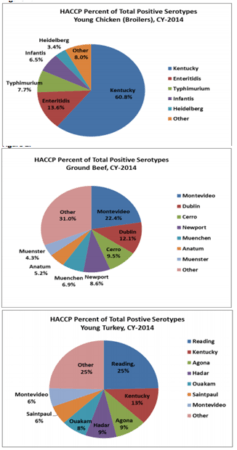16 years of Salmonella Trends reported by FSIS
 USDA (FSIS) reports that Salmonella is the leading cause of bacterial foodborne illness in the United States and causes an estimated 1.2 million illnesses, 19,000 hospitalizations and 380 deaths, each year. The data from 2014 estimates that 360,000 (30%) of foodborne illnesses are attributed to FSIS-regulated products, which is a 9.3% decrease compared to 2010.
USDA (FSIS) reports that Salmonella is the leading cause of bacterial foodborne illness in the United States and causes an estimated 1.2 million illnesses, 19,000 hospitalizations and 380 deaths, each year. The data from 2014 estimates that 360,000 (30%) of foodborne illnesses are attributed to FSIS-regulated products, which is a 9.3% decrease compared to 2010.
Serotyping
FSIS conducted ednontyphoidalSalmonella serotype testing on isolates recovered from raw meat and poultry products, subject to sampling under the Pathogen Reduction Hazard Analysis and Critical Control Point (PR/HACCP) verification testing program. The results presented here provide an estimate of relative serotype distributions for each product class during the 16-year period following implementation of the PR/HACCP program (1998-2014). The top 10 Salmonella serotypes identified from the testing in 2014 are listed in Table 1a. Different types of Salmonella serotypes were found in the various types of meat and poultry.
The top 10 Salmonella serotypes identified from the testing in 2014 are listed in Table 1a. Different types of Salmonella serotypes were found in the various types of meat and poultry.
Young Chicken Carcass (Broiler):
In 2014, 8,816 young chicken carcass samples were analyzed. Salmonella was isolated from 3.7% (325/8816) of these samples. Of the positive broiler samples, 60.8% (197/325) were positive for S. Kentucky followed by Salmonella Enteritidis 13.6% (44/324). Since 1998, Salmonella Kentucky has ranked as the most common serotype identified among PR/HACCP young chicken isolates. Salmonella Kentucky from chicken carcasses, however, is not among the serotypes commonly associated with human illness in the U.S. Salmonella Enteritidis was the second most common serotype identified in young chicken carcasses and is currently the most common serotype associated with human illness.
Ground Beef
In 2014, 7,320 ground beef samples were analyzed Salmonella was isolated from 1.6% (116/7,320) of these samples which is a decrease since 2011. Of the ground beef positive samples, 22.4% (26/116) were positive for Salmonella Montevideo followed by Salmonella Dublin (12.1%) 14/116. Since 1998, S. Montevideo has ranked as the most common serotype identified among PR/HACCP ground beef isolates. S. Montevideo from ground beef, however, is not among the serotypes commonly associated with human illness in the U.S. In 2014, S. Dublin was reported to cause more severe illness than any other non-typhoidal Salmonella, although it is an uncommon cause of human illness. Salmonella Dublin was found to cause highest rate of hospitalization (67%), invasive infection (64%) and deaths (3%) when compared to other serotypes analyzed in the study. Salmonellosis caused by S. Dublin is frequently multi-drug resistant.
Young Turkey Carcass
In 2014, 1,919 young turkey samples were analyzed under the PR/HACCP program. Salmonella was isolated from 1.7% (32/1919) of these samples which is a decrease from 2013.Of the young turkey positive samples, 25.0% (8/32) were positive for S. Reading. Since 2012, Salmonella Reading has ranked among the top three serotypes identified. S. Reading has not been considered a major contributor to human salmonellosis from turkey products in the U.S.

